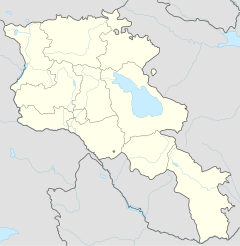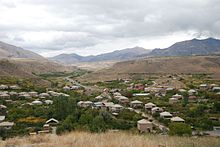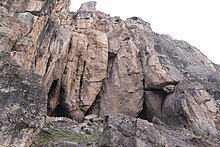Areni
|
Areni Արենի |
||
| State : |
|
|
| Province : | Vajoz Dzor | |
| Coordinates : | 39 ° 43 ' N , 45 ° 11' E | |
| Height : | 1054 m | |
| Residents : | 1,566 (2011) | |
| Time zone : | UTC + 4 | |
| Community type: | Rural community | |
| Mayor : | Seryozha Suqiasyan ( HHK ) | |
|
|
||
Areni ( Armenian Արենի ), formerly Arpa is a village in the south Armenian province of Vayots Dzor Province with 1,566 inhabitants in 2011. The location on 1054 meters above sea level primarily as a wine region in the fertile valley of the Arpa and because of his 1321 completed Surb-Astwazazin -Church known. In the nearby Areni 1 cave , the world's oldest, fully preserved leather shoe and the oldest wine production from the Copper Age were discovered.
location
Areni is on the M2 , the only expressway that connects Yerevan with the southern part of the country. After the top of the pass on the border between the provinces of Ararat and Wajoz Dzor, the M2 runs steadily downhill past the first mountain village Jelpin to the south to the Arpa valley. The valley, which is used intensively for agriculture, with its small plots of vineyards and trees, contrasts with the grassy and partly rocky hills. The town center is one kilometer south of the M2 on a side road that continues to the hamlet of Amaghu (belongs to the rural community of Areni, no permanent residents in 2011) and to the village of Chatschik on the closed border with Nakhichevan .
One kilometer east of Areni, a road branches off from the M2 to the Norawank monastery , which was built shortly before the end of a picturesque rock valley. In the area of the narrow gorge at the beginning of the valley, the karst rocks contain numerous other caves, some of which are widely branched, in addition to the Areni 1 cave. The road to Chatschik, which runs roughly parallel to the top, offers views of the Noravank Valley. The distance from Areni to the provincial capital Yeghegnadzor is 17 kilometers; The wine-producing villages of Arpi and Getap are on the route along the Arpa.
On a hill on the road towards Amaghu, small remains of the Hraschkaberd fortress, which is mentioned around 1299, have been preserved. Several shrines near the village are religiously venerated, including the Surb Sarkis rock cave and a shrine called Surb Grigor Nahatak , which is dedicated to Tukh Manuk .
history
Archaeological excavations in the years after the turn of the millennium have uncovered finds made of organic material in the dry climate of the nearby caves, which date back to the Copper Age. In September 2008, a team of Armenian, Irish and American archaeologists hid in the cave Areni 1 , also known as the “bird cave”, the oldest completely preserved leather shoe to date, which dates back to around 3500 BC. Is dated. The cave was from 5000 to 3000 BC. Inhabited. Clay pots that had served as storage containers for grain, apricots and other food were also uncovered in it. At around 4000 BC BC archaeologists at the University of California appreciate a 2010 public wine press that was in the same cave. The press used to process grapes of the current genus Vitis vinifera and the clay jugs that go with them show that wine production must have been at a well developed stage.
Other finds in the area range from the Bronze Age , the Iron Age in the 1st millennium BC. Until the time of ancient Greece , when the place was called Arpaneal. From 114 AD, the local Greek settlers were briefly under the rule of the Roman emperor Trajan (ruled 98–117). Subsequent Roman emperors left the regional administration to Armenian princes. The exercise of power by the Arsacids ended in 163 with the Roman military Statius Priscus , who invaded Armenia at the beginning of the year, conquered the capital Artaxata ( Artaschat ) and installed a Roman ruler instead of the Armenian. According to its Greek inscription, an altar published in 1989 that belonged to a temple dates from AD 163. It provides the first evidence that there must have been a mother goddess addressed as Ge Meter Olybris as a female counterpart to Zeus Olybris, comparable with Demeter and Cybele . The inscription was written by a Roman soldier named Aemilius Ovalis (Emilius Valens), whose legion camped here for an unknown time. It was not until the Sassanids defeated the Roman army at Barbalissos on the Euphrates in 253 that Roman influence ended.
The region on the Arpa River belonged to the center of the principality of the Orbelian Dynasty since the end of the 13th century. In the vicinity of the place ruins have been found that may have belonged to the palace of Prince Tarsayich Orbelian in the 13th century. He also had a bridge built over the Arpa between 1265 and 1287. While the north of today's Armenia suffered under Mongol rule in the 14th century , the regions of Arpa and, further south, Sjunik experienced a cultural heyday with the independent Orbelian princes. With her patronage, numerous churches and new buildings were built on existing monasteries. According to the founding inscription, the Church of Our Lady ( Surb Astwazazin ) was completed in 1321 . At that time, your architect Momik was working for Bishop Hovhannes Orbelian in the Noravank monastery.
After the mass deportation of the Armenian population to Isfahan in 1604 by the Persian Shah Abbas I , the villages were deserted and viticulture in the region came to a standstill. Only a few varieties could be preserved until the 19th century, when Armenia belonged to the Russian Empire and viticulture was promoted again. In 1840 an earthquake shook the area, in which the Areni Church was badly damaged.
Townscape
According to official statistics from 2008, Areni has 1865 inhabitants. There is a large modern wine factory (Areni Winery) on the M2 expressway near the junction to the town center . Over a length of about one kilometer, small stalls offer dry country wine, mostly in two-liter plastic bottles, and vegetables.
The one or two-story houses in the village are covered with fiber cement panels. Winter fodder is stored in haystacks for the cattle that graze on the surrounding hills. A footbridge over the Arpa directly below the church is no longer accessible. The way there on the hill on the southern bank of the river opposite the village begins at a road bridge on the road towards Chatschik half a kilometer south.
Web links
- Rick Ney: Vayot's Dzor. (PDF; 1.7 MB) TourArmenia, 2009, p. 3
- Areni Village. Armeniapedia
Individual evidence
- ↑ Vajoz Dzor : Results of the 2011 census at the Armenian statistical office (PDF; Armenian)
- ↑ Hasmik Smbatian: Oldest Leather Shoe. A 'Dream' Find For Armenian Scientist . azatutyun.am, June 12, 2010
- ^ Hans Barnard, Alek N. Dooley, Gregory Areshian, Boris Gasparyan, Kym F. Faull: Chemical evidence for wine production around 4000 BCE in the Late Chalcolithic Near Eastern highlands. (PDF; 1.2 MB) Elsevier, 2010
- ^ Thomas H. Maugh: Ancient winery found in Armenia. Los Angeles Times, Jan. 11, 2011
- ↑ Jurij G. Vinogradov: The Goddess "Ge Meter Olybris". A New Epigraphic Evidence from Armenia. In: East and West, Vol. 42, No. 1. Istituto Italiano per l'Africa e l'Oriente (IsIAO), March 1992, pp. 13-26, here pp. 17-19
- ↑ RA Vayots Dzor Marz. (PDF; 165 kB) armstat.am




